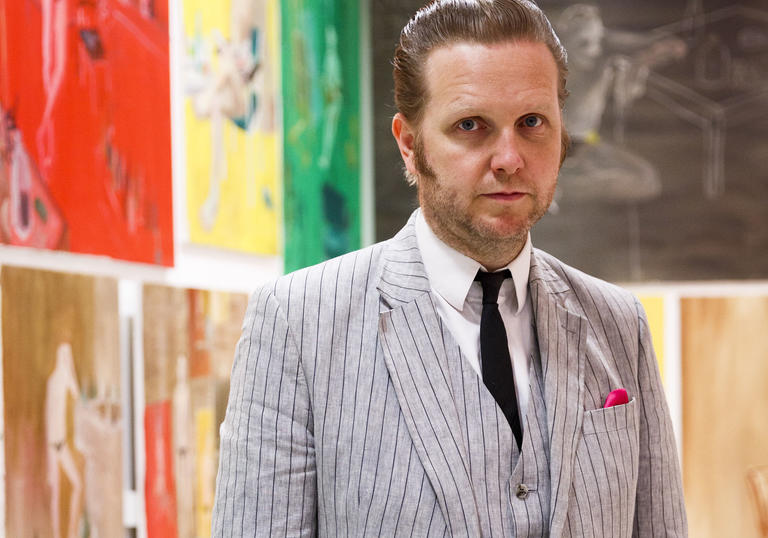How influential has your native Iceland been on your art?
It has been hugely influential. It is an island of stories, not visual things. Therefore the conceptual is pretty important to me and to most artists from there. Retinal art is not really a thing in Iceland. Also the art, music, literature scene is fantastic. Damn, I love it. Constantly inspiring. It’s just fun and chaotic, sometimes pretty frustrating. It is like the Sicily of the north, very vibrant, strong family ties, volcanic activity and mafia. (But our mafia is stronger, they don’t need to kill anyone, they just own and rule everything.)
Iceland is like the Sicily of the north, very vibrant, strong family ties, volcanic activity and mafia
You initially wanted to study painting at art school. What prompted you to shift your focus?
Just modern times and cool people.
The interplay between reality and fiction permeates your work. How did you first become interested in the duality of these ideas?
I think when I was an altar boy. Once a priest said to me, ‘Ragnar, always when you make a mistake, pretend it’s ritual.’ Well, that’s the mundane meeting the sublime, or reality meeting fiction.
One of the earliest pieces in the exhibition is a series of works entitled Me and My Mother (2000), in which your mother spits at your repeatedly. How did this work evolve and how did your mother initially react when you asked her to be involved?
My mother became a bad actress because she loved her son.
I made the work the year before I graduated from art school. I was on a course with Aernout Mik, a very good Dutch video artist. I really wanted to impress him, so I made this video where my mother spits on my face. He was not impressed but I will always be thankful for this. He told me flat out, ‘This is crap! You can obviously see that she is acting. She is pretending to spit on you, the work has no violence! It is fake violence and it is just not interesting.’ I was devastated. But when I started thinking about what he said, it was as if he had spoken magic words. I realised it was the fact that it was acted out that made it interesting. It was the fakeness of it that made it so real – if it had looked like it was not fake then it would have been theatre. My mother became a bad actress because she loved her son. My mum was absolutely cool. Just said yes, laughed and said, ‘Ehm, up for anything honey. Is it you spitting on me, or me spitting on you?’
Repetition is a recurring theme throughout your work. You collaborated with the American rock band The National to perform their song ‘Sorrow’ over and over again for six hours at MoMA PS1 in New York, which is on show at the Barbican. How did this piece come about, and by repeating the performance what does this do to the viewer’s experience?
I can’t really answer for the viewer. But the piece came about as I wanted to do an artwork about a song. Making a song sculptural or painterly. This song by The National was just the perfect subject. Through repetition, you turn performance into a mass. That’s what I really liked when I was in art school and learned about the 1970s performances – these artists were turning the everyday into a piece of art. It reminded me of what I had always seen in the theatre – actors repeating the same sentence over and over during rehearsals – and I realised that if you take one element and repeat it, then it becomes a sculpture
'Take Me Here by the Dishwasher: Memorial for a Marriage' (2011/14) will be performed daily during the exhibition. The work consists of ten troubadours singing and playing the guitar, with a loop of the film Morðsaga (1977) featuring your parents in the background in a makeshift domestic setting. How did the idea for this work develop?
I collaborated with Kjartan Sveinsson, composer and friend, on a piece that was about troubadours playing guitar in a spatial music cacophony. Just instrumental. We first did it in Charlottenburg in Denmark, then in the Carnegie Museum in Pittsburgh. Then it was just guitars and males. But when I was asked to do a show at the BAWAG Contemporary in Vienna I suddenly got this idea to mix the guitars with a film of my parents. My parents did this sex scene in a film shot in May 1975, then I was born in February 1976. Family lore has it I was conceived that same night. I had for years wanted to do something with that clip of my parents having soft, erotic, 1970s sex. It’s like having this crazy readymade in your family. Then I asked Kjartan to make melodies from the dialogue of my parents. Then the piece was born.

